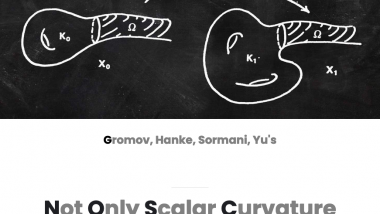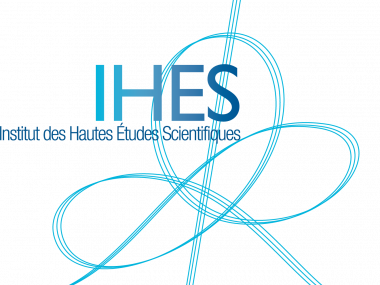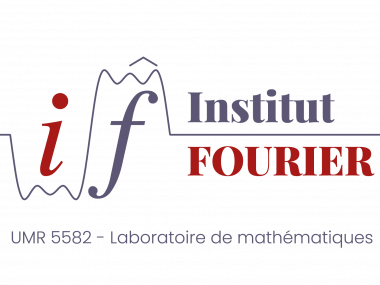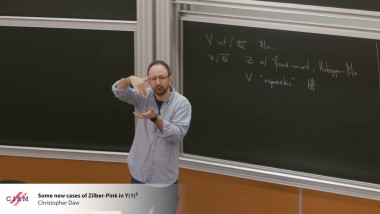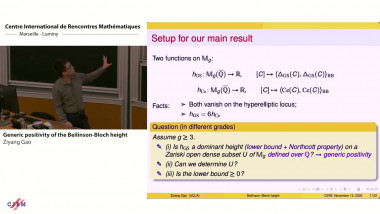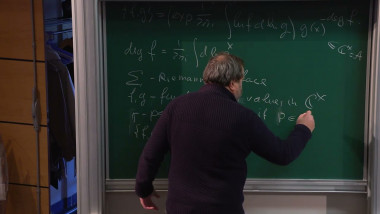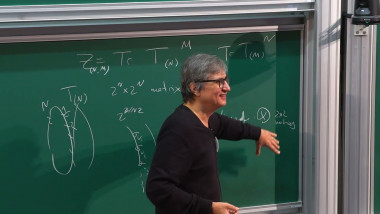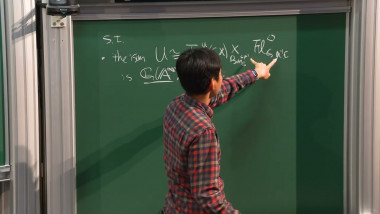Automorphism groups of algebraic curves in positive characteristic.
Apparaît dans la collection : AGCT 2025 - Arithmetic, Geometry, Cryptography and Coding Theory / AGCT 2025 - Arithmétique, Géométrie, Cryptographie et Théorie des Codes
Algebraic curves in positive characteristic and their function fields have been a source of great interest ever since the seminal work of Hasse and Weil in the 1930s and 1940s. Many important and fruitful ideas have arisen out of this area, where number theory and algebraic geometry meet, including the famous application to error-correcting codes given by Goppa's AG codes.
Let $\mathcal{X}$ be a projective, geometrically irreducible, non-singular algebraic curve defined over an algebraically closed field $\mathbb{K}$ of positive characteristic $p$. Let $\mathbb{K}(\mathcal{X})$ be the field of rational functions on $\mathcal{X}$ (i.e. the function field of $\mathcal{X}$ over $\mathbb{K}$ ). The $\mathbb{K}$-automorphism group $\operatorname{Aut}(\mathcal{X})$ of $\mathcal{X}$ is defined as the automorphism group of $\mathbb{K}(\mathcal{X})$ fixing $\mathbb{K}$ element-wise. The group $\operatorname{Aut}(\mathcal{X})$ has a faithful action on the set of points of $\mathcal{X}$.
By a classical result by Schnid (1938), Aut( $\mathcal{X}$ ) is finite whenever the genus $g$ of $\mathcal{X}$ is at least two. Furthermore it is known that every finite group occurs in this way, since, for any ground field $\mathbb{K}$ and any finite group $G$, there exists an algebraic curve $\mathcal{X}$ defined over $\mathbb{K}$ such that $\operatorname{Aut}(\mathcal{X}) \cong G$ (see for example the work of Valentini-Madden, 1982).
This result raised a general problem for groups and curves, namely, that of determining the finite groups that can be realized as the $\mathbb{K}$-automorphism group of some curve with a given invariant. The most important such invariant is the genus $g$ of the curve. In positive characteristic, another important invariant is the so-called $p$-rank of the curve, which is the integer $0 \leq \gamma \leq g$ such that the Jacobian of $\mathcal{X}$ has $p^7 p$-torsion points.
Several results on the interaction between the automorphism group, the genus and the $p$-rank of a curve can be found in the literature. A remarkable example is the work of Nakajima (1987) who showed that the value of the $p$-rank deeply influences the order of a $p$-Sylow subgroup of $A u t(\mathcal{X})$. Extremal examples with respect to Nakajima's bound are known from the work of Korchmáros-Giulietti (2017) and Stichtenoth (1973). The following open problem arose naturally:
Open Problem 1: How large can a d-group of aulomorphisms $G$ of an algebraic curve $\mathcal{X}$ of genus $g \geq 2$ be when $d \neq p$ is a prime number? Is there a method to construct extremal cxamples as for the case $d=p$ ?
In his work Nakajima also analyzed the case of curves for which the $p$-rank is the largest possible (the so-called ordinary curves), namely $\gamma=g$, proving that they can have at most $84\left(g^2-g\right)$ automorphisms. Since no extremal examples for this bound were found by Naka.jima, also the following open problem arose naturally:
Open Problem 2: Is Nakajima's bound $\mid$ Aut $(\mathcal{X}) \mid \leq 84\left(g^2-g\right)$, sharp for an ordinary curve $\mathcal{X}$ of genus $g \geq 2$ ?
Hurwitz (1893) showed that if $\mathcal{X}$ is defined over $\mathbb{C}$ then $|A u t(\mathcal{X})| \leq 84(g-1)$, which is known as the Hurwitz bound. This bound is sharp, i.e., there exist algebraic curves over $\mathbb{C}$ of arbitrarily high genus $g$ whose automorphism group has order exactly $84(g-1)$. Well-known examples are the Klein quartic and the Fricke-Macbeath curve.
Roquette (1970) showed that Hurwitz bound also holds in positive characteristic $p$, if $p$ does not divide $|\operatorname{Aut}(\mathcal{X})|$. A general bound in positive characteristic is $|\operatorname{Aul}(\mathcal{X})| \leq 16 g^4$ with one exception: the so-called Hermitian curve. This result is due to Stichtenoth (1973). The quartic bound $|A u t(\mathcal{X})| \leq 16 g^4$ was improved by Henn (1978). Henn's result shows that if $|A u t(\mathcal{X})|>8 g^3$ then $\mathcal{X}$ is $\mathbb{K}$-isomorphic to one of 4 explicit exceptional curves, all having $p$-rank equal to zero. A third natural open problem arose as a consequence of this result:
Open Problem 3: Is it possible to find a (optimal) function $f(g)$ such that the existence of an automorphism group $G$ of $\mathcal{X}$ with $|G|>f(g)$ implies that $\mathcal{X}$ has p-rank zero?
Henn's result clearly implies that $f(g) \leq 8 g^3$, but it is pleausible to believe that a quadratic bound with respect to $g$ could also be found.
In this talk, we will describe our main contributions to the three problems mentioned above and more generally in understanding the relation between automorphism groups of algebraic curves in positive characteristic and the other invariants mentioned above. If time allows, applications of these results in determining isomorphism classes of algebraic curves over finite fields will also be discussed.

